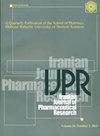The Interaction of SRL-2 Peptide with LRP-1 Receptor and Identification of Breast Cancer Related Biomarkers: An In-silico Approach
IF 1.8
4区 医学
Q3 PHARMACOLOGY & PHARMACY
引用次数: 0
Abstract
Background: Breast cancer is a multifaceted disease characterized by genetic and epigenetic changes that lead to uncontrolled cell growth and metastasis. Early detection and treatment are crucial for managing diseases. Objectives: The objective of this study is to investigate the potential of chimeric peptides for drug delivery and to identify biomarkers associated with breast cancer. Recent studies have shown that the low-density lipoprotein receptor-related protein 1 (LRP-1) receptor has a significant impact on the development of breast cancer. In order to facilitate the identification of biomarkers, we have created a chimeric peptide that has been proven to bind successfully to the LRP-1 receptor. Methods: To identify biomarkers, we utilized advanced computational methods to conduct a meta-analysis of microarray data. Specifically, the g:Profiler and eXpression2Kinases (X2K) databases were utilized to identify gene ontologies and transcription factors. We then used the Human Protein Atlas to identify and assess crucial gene expressions. Results: Our results demonstrated that nucleolar and spindle-associated protein 1 (NUSAP1), melatonin receptor 1A (MELT), and cyclin-dependent kinase 1 (CDK1) are three hub genes that play pivotal roles in the pathogenesis of breast cancer. Conclusions: The research findings provide a deeper understanding of the molecular mechanisms involved in developing breast cancer. These findings have significant implications for developing novel therapies and diagnostics for this disease.SRL-2肽与LRP-1受体的相互作用及乳腺癌相关生物标志物的鉴定:一种计算机方法
背景:乳腺癌是一种多面性疾病,其特征是遗传和表观遗传改变,导致细胞生长和转移失控。早期发现和治疗对于控制疾病至关重要。目的:本研究的目的是研究嵌合肽用于药物传递的潜力,并确定与乳腺癌相关的生物标志物。近年来的研究表明,低密度脂蛋白受体相关蛋白1 (LRP-1)受体在乳腺癌的发生发展中具有重要影响。为了方便生物标志物的鉴定,我们已经创建了一个嵌合肽,已被证明可以成功地与LRP-1受体结合。方法:为了识别生物标志物,我们利用先进的计算方法对微阵列数据进行了荟萃分析。具体来说,利用g:Profiler和expression2激酶(X2K)数据库来识别基因本体和转录因子。然后,我们使用人类蛋白质图谱来识别和评估关键基因的表达。结果:我们的研究结果表明,核仁和纺锤体相关蛋白1 (NUSAP1)、褪黑素受体1A (MELT)和细胞周期蛋白依赖性激酶1 (CDK1)是三个在乳腺癌发病机制中起关键作用的枢纽基因。结论:本研究结果对乳腺癌发生的分子机制有了更深入的了解。这些发现对开发新的治疗方法和诊断方法具有重要意义。
本文章由计算机程序翻译,如有差异,请以英文原文为准。
求助全文
约1分钟内获得全文
求助全文
来源期刊
CiteScore
3.40
自引率
6.20%
发文量
52
审稿时长
2 months
期刊介绍:
The Iranian Journal of Pharmaceutical Research (IJPR) is a peer-reviewed multi-disciplinary pharmaceutical publication, scheduled to appear quarterly and serve as a means for scientific information exchange in the international pharmaceutical forum. Specific scientific topics of interest to the journal include, but are not limited to: pharmaceutics, industrial pharmacy, pharmacognosy, toxicology, medicinal chemistry, novel analytical methods for drug characterization, computational and modeling approaches to drug design, bio-medical experience, clinical investigation, rational drug prescribing, pharmacoeconomics, biotechnology, nanotechnology, biopharmaceutics and physical pharmacy.

 求助内容:
求助内容: 应助结果提醒方式:
应助结果提醒方式:


